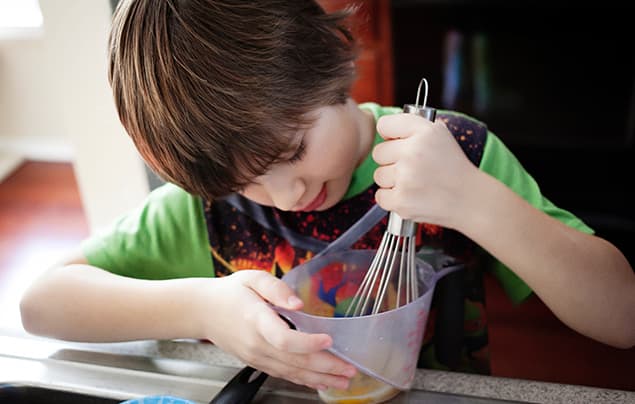STEM cooking tricks to teach your kids
These tasty experiments double as tips for kids (and parents!) to brush up their chef skills…
Your kids probably won’t get too excited over an impromptu science lesson – unless it means mixing up an experiment they can eat. Plus, it turns out that the science of cooking isn’t as boring as it sounds…
In fact, lots of easy techniques that chefs use rely on STEM-ready concepts. We asked them to share their best science-based cooking secrets to help get food on the table and sneak in some academics.
Kid-friendly technique: measuring liquids
What they’ll learn about: Viscosity
What they’ll do: Let the kids fill a clear measuring cup to what they think is 200ml of any liquid. Place it on a flat surface and have them look at it at eye level. They’ll see that the liquid isn’t flat – it dips in the centre. That’s the meniscus – the point where chemists measure liquids. Kids will discover that what looked like the right amount from above is actually more or less liquid that they thought.
Cool science: Viscosity is the resistance to flow – in other words, how thick something is. Something with a low viscosity has a lot of liquid, and that’s why measurements of liquids matter so much.
Why you should try it: “Too much liquid will lower viscosity of a batter,” says professor Melani W. Duffrin of Northern Illinois University’s School of Interdisciplinary Health Professions. “So, for instance, a pancake batter with low viscosity – or too much liquid – would spread more, resulting in a flatter product,” she says. But get the liquid measurement right, and those pancakes will plump right up.
Kid-friendly technique: salting salad
What they’ll learn about: Osmosis
What they’ll do: With your help, have kids chop a tomato, then place the pieces in a mesh strainer over a bowl. Sprinkle with salt. As salt seeps into the tomato, water from the fruit will drip out.
Cool science: Water and other molecules pass through membranes via a process called osmosis. In this case, the membrane is the tomato’s skin. The concentration of water and salt molecules must be equal inside and outside the tomato, so as salt flows in, water flows out.
Why you should try it: Because of osmosis, salting food draws out water. So, if you salt, say, cucumbers or tomatoes before adding them to a salad bowl, you won’t end up with a lot of liquid at the bottom of the bowl.
Kid-friendly technique: whisking
What they’ll learn about: Emulsion
What they’ll do: Have kids pour one part vinegar and three parts oil into a mixing bowl, then whisk it together. In a separate bowl, add the same amount of vinegar and oil plus 1.5 tablespoons of Dijon mustard, and whisk together. Transfer the mixtures into two separate jars and watch the ingredients separate.
“You should see the mustard mixture hold together longer,” says Daniel Gritzer, managing culinary director of Serious Eats, a website dedicated to recipes and cooking techniques. “If kids give each one a vigorous shaking, they can bring both of them back together.” Then one more time, observe which one separates quicker. The science of cooking in action!
Cool science: Mustard contains lecithin, an emulsifier. Emulsifiers are compounds that possess both ‘hydrophilic’ (water-loving) and ‘lipophilic’ (fat-loving) properties. “The mustard emulsifier helps the water molecules in the vinegar hang out with the fat molecules in the oil,” Gritzer says. “That’s why the oil and vinegar doesn’t separate as quickly.”
Why you should try it: Using an emulsifier means a much creamier dressing for your salad.
Kid-friendly technique: dehydrating meat
What they’ll learn about: Maillard reaction
What they’ll do: Have kids wrap one piece of raw meat tightly in plastic and a similar-size piece on a wire rack over a plate to try out. (Make sure kids wash hands thoroughly before and after handling raw meat.) Refrigerate both for at least an hour, then help them sear each piece separately in a skillet. The exposed piece will brown and crisp much more than the pre-wrapped piece, developing a richer taste.
Cool science: Heat causes sugar and protein molecules to combine and recombine, forming new molecules and distinct flavours. Called the Maillard reaction, it’s what gives browned foods like steak their rich taste. “New and more complex flavours come out as the reaction goes along,” Gritzer says.
Why you should try it: Surface moisture takes time to cook off, so wetter meat is often done before the Maillard reaction can fully take place. “But if you dry the meat before you cook, all those flavour compounds permeate it,” says chef Bertram Whitman of Los Angeles.
Kid-friendly technique: weighing salt
What they’ll learn about: Crystal formation
What they’ll do: Have kids weigh an amount of table salt and the same amount of kosher salt on a food scale. Then check out both under a magnifier. The kosher salt crystals should weigh a little less and look larger.
Cool science: Salt crystals form when water with dissolved ‘solute’ – that is, salt minerals – evaporates. All salt crystals naturally form a cube shape, but they’ll grow bigger or smaller depending on the evaporation speed. Water that evaporates slowly yields bigger salt crystals. “Your larger crystals are going to require more volume (i.e. space) to acquire the same weight,” says Duffrin, creator of FoodMASTER, which teaches maths and science using food experiments.
Why you should try it: Weighing salt for a recipe could make the difference between something you want to eat and something you… don’t. Duffrin points out that one teaspoon of table salt is generally equivalent to 1.25 teaspoons of kosher salt.















LEAVE A COMMENT
THANK YOU
Your comment will be checked and approved shortly.
WELL DONE,
YOUR COMMENT
HAS BEEN ADDED!
COMMENTS
CUSTOMIZE YOUR AVATAR